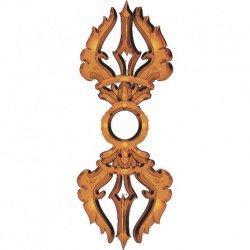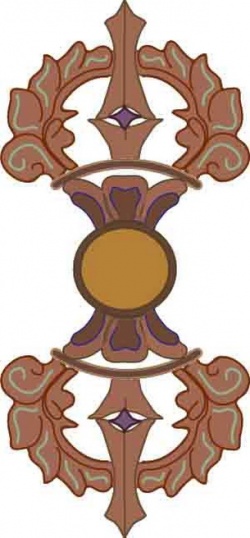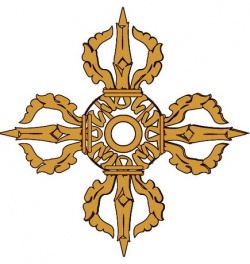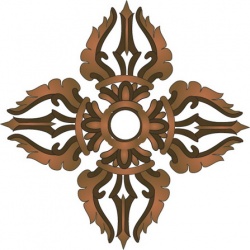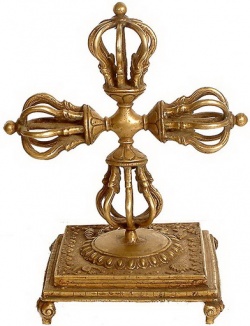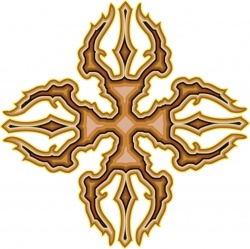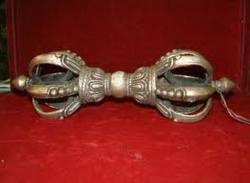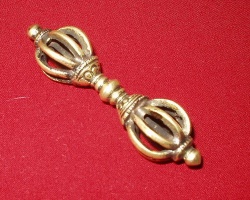Vajra - Dorje - Benzar - Thunderbolt - Firespade - Keraunos
"Then like a bull who has heard the crash of a thunderbolt close by, the Great Soul whose mind had been purified by the merit of karma accumulated from eons of virtuous actions, was deeply agitated at this news of old age." (Ashvaghosha. Acts of the Buddha, Book III: 34) The thunderbolt here, represents the realization of urgency. It stands for the motivation; the impetus to accomplishment.
The word for the ritual implement held in the lama's right hand has been translated as thunderbolt but also diamond. The Sanskrit word vajra has the connotation of adamantine, that is, "unbreakable," or, "impregnable."* Therefore, besides being able to dent any object and overwhelm with its incomparable brilliance, the vajra or dorje represents great durability -- a hardness plus an immutability that is practically eternal. Ultimately, it stands for
The mystery of the mind, the omniscience, the pure awareness of all the Buddhas,
Indicated by a symbol of eternal strength and constancy,
The vajra heart of knowledge and emptiness is like the sky --
How wonderful to see the intrinsic face of reality!
Dorje is the Tibetan word for vajra. Do-rje means noble stone > Do = stone and rJe = noble or prince. It embodies not only the brilliance of refracted or reflected illumination, but it also symbolizes the impervious and fixed solidity of the point of power around which all else turns -- the axis mundi or hub of the world.
A dorje, then is like the diamond, but that gem is an inadequate symbol for it. However, just as any other substance will be destroyed on impact with a diamond, so the ritual object symbolizes that which is indestructible, enduring, powerful, invincible, and irresistible. For example, although the name, Vajravarahi, has often been translated into English as "Diamond Sow," the word diamond is inadequate and even misleading. Indomitable might be better.
Vajra is a Sanskrit equivalent of the Tibetan word dorje and it carries many meanings: Indra’s thunderbolt, the lamas’ sceptre, and diamond, but only in the sense mentioned above. It may also be used as a qualifying term for anything used in the tantric context. Thus the person who presides at tantric rituals is called the vajra master or dorje lopon.
Bajrang is a variant transliteration of other Indian language words for vajra.
Benzar as in benzar guru for vajra guru is a Tibetan mispronunciation of vajra, but it might also derive from the Persian pad-bazar which means antidote and gives us the English word, bezoar. (The first vajra was indeed an antidote. Indian tradition says that it was created from the bones of primordial saint, Dadhichi, to counter forces of evil that were wreaking havoc in the world. Indra, as chief of the opposing forces, was the first to use it.)
Chin-kang (PY: Jingang) is the Chinese, and Kongo, the Japanese, word used for the thunderbolt.
The giant dorje of Swayambhunath, Nepal that is associated with Karmapa Rangjung Dorje.
Structure of the Vajra
Robert Beer in The Encyclopedia of Tibetan Symbols and Motifs explains the elements of the five-pronged vajra:
At the centre of the vajra is a flattened sphere representing the dharmata as the 'sphere of actual reality.' This sphere is sealed within by the syllable HUM, whose three component sounds represent freedom from karma ([the Sanskrit letter,] Hetu,) freedom from conceptual thought (Uha) and the groundlessness of all dharmas (M.)
On either side of the central hub are three rings [which] symbolize the spontaneous bliss of Buddha nature as emptiness, signlessness and effortlessness.
Emerging from the three rings on either side are two eight-petalled lotuses. The sixteen petals represent the sixteen modes of emptiness. The upper lotus petals also represent the eight bodhisattvas, and the eight lower petals, the eight female consorts.
Above the lotus bases are another series of three pearl-like rings, which collectively represents the six perfections of patience, generosity, discipline, effort, meditation and wisdom. A full moon disc crowns each of the lotuses, symbolising the full realisation of absolute and relative bodhichitta.
Emerging from the moon discs are five tapering prongs, forming a spherical cluster or cross. The four [outer] ... prongs curve inwards to the central prong, symbolising that the four aggregates of form, feeling, perception and motivation depend upon the fifth aggregate of consciousness. The five upper prongs of the vajra represent the Five Buddhas (Akshobhya,Vairochana, Ratnasambhava, Amitabha and Amogasiddhi,) and the unity of their five wisdoms, attributes and qualities. The five lower prongs represent the female consorts of the Five Buddhas (Mamaki, Lochana, Vajradhatvishvari, Pandara and Tara) and the unity of their qualities and attributes. The Five Buddhas and their consorts symbolize the elimination of the five aggregates of personality. The ten prongs together symbolize the ten perfections (the six mentioned above plus skilful means, aspiration, inner strength, and pure awareness;) the 'ten grounds' or progressive levels of realisation of a bodhisattva; and the ten directions.
Each of the outer prongs arise from the heads of Makaras (sea monster). The four Makaras symbolise the four immeasurables (compassion, love, sympathetic joy and equanimity;) the four doors of liberation (emptiness, signlessness, wishlessness and lack of composition;) the conquest of the four Maras (emotional defilements, passion, death, divine pride and lust;) the four activities or karmas; the four purified elements (air, fire, water, earth;) and the four joys (joy, supreme joy, the joy of cessation and innate joy.)
The tips at the end of the central prong may be shaped like a tapering pyramid or four-faceted jewel, which represents Mount Meru as the axial centre of both the outer macrocosm and inner microcosm.
The twin faces of the symmetrical vajra represent the unity of relative and absolute truth.
Nine Points
Sometimes a vajra is depicted / described as having 9 rather than 5 tips at the ends. This form seems to be related to the nine stages of the Nyingmapas. According to Jeff Watt, some older Tibetan texts refer to the "regular" 5-pointed vajra as a " 9- pointed vajra." In this case, the enumeration derives from the 1 central prong that extends from one end to the other, plus the 4 prongs at each end that surround the tips.
Aspects of the Vajra
Wielding the Vajra
In Buddhist iconography a thunderbolt or a dorje in the hand of a deity or a teacher represents the determination to apply "skillful means," technique or method. It stands for the ultimate solution -- the application of Dharma, as in the story of Prince 5-weapons' confrontation with the ogre called Sticky-Hair.
After letting loose a poisoned arrow that only got caught in the forest ogre's hair, the prince shot off another 50 arrows, all with the same impotent result.
He then tried another weapon, his sword, but it too could not penetrate the ogre's hair. He then tried using his spear, club and fists, but nothing worked. It was just before the ogre was about to feast that the prince revealed his 6th weapon. He said, "Ogre, why should I be afraid? for in one life, death is certain. What's more, I have in my belly a thunderbolt for a weapon. It will tear your insides to shreds and will kill you. Then we will both perish. That's why I am not afraid." ~ retold by Joseph Campbell, Hero with a 1000 Faces.
Padmasambhava, Guru Rinpoche (Precious Teacher) is depicted in 8 ways that commemorate events in his legendary life. When the ministers of the King of Udyana try to burn Guru Rinpoche and his consort alive, he transforms the flames of the pyre into a lake. The form he assumed when he emerged in the centre of a lotus with Mandarava is known as Guru Pema Dorje Tsal -- the Guru with Lotus and Vajra. In this form, he is invoked as Benzar Guru, another way of saying Vajra Guru.
Paired With the Bell
The vajra or dorje and its complementary object, the bell (Skt.: ghanta) are the characteristic ritual implements of Vajrayana or the tantric methods of Buddhism. While the dorje with its masculine associations represents the compassion of all the Buddhas, the ghanta (Tib.: drilbu) represents wisdom, which in this context is considered a female principle. To achieve enlightenment the two principles should work in harmony. In the Buddhist tradition, the bell is visualized as the body, the dorje is the mind. The sound of the bell is regarded as the speech of the Buddha. It can also be a focus for the contemplation of Impermanence.
The two objects in association may derive from the ritual or puja of the Bengali goddess Durga who is an embodiment of all the powers of the gods. At her birth, she received the vajra from Indra and the bell from his white-skinned elephant, Airavata.
Transmutations
According to legend, Indra's thunderbolt was fashioned from the bones of the great Rishi Dadhichi, who was decapitated by Indra in sacrifice. Dadhichi's 'indestructible' skull-bones gave Indra the most powerful of weapons. By its energy he slew innumerable of his enemy demons. In mythological descriptions, Indra's thunderbolt or vajra is shaped either like a circular discus with a hole at its center, or in the form of a cross with transverse bladed bars. The Rigveda, the most ancient text in the world, identifies the vajra as a notched metal club with a thousand prongs. What is significant is that all these descriptions identify the vajra as having open prongs, unlike the Buddhist one, which has closed prongs. According to a Buddhist legend, Shakyamuni took the vajra weapon from Indra and forced its wrathful open prongs together, thus forming a peaceful Buddhist scepter with closed prongs. The Buddhist vajra hence absorbed the unbreakable and indestructible power of the thunderbolt.
So, in its usual closed form, the vajra is the tool of peaceful or benign embodiments of compassion. The open dorje is associated with the wrathful deities who wield it compassionately but with righteous anger judiciously applied.
It most often has five prongs on each end but as we have seen, sometimes it has nine. The Buddhist deity called Vajrakilaya is generally depicted holding one of each. It can have other numbers of prongs, too, including one with a single point at each end.
In tantric rituals and worship, Hindu and Buddhist, consecrated objects are considered to take on the vajra-character, so that there are vajra-pushpa (vajra-flowers,) a vajra-bhumi (vajra-ground,) and so on.
The five-pronged (2 plus 3) pair of the Japanese wisdom deity, Kongo.
Vajra Buddhas
There are 5 buddha families; two are associated with the dorje. Akshobhya is the Vajra Family buddha, the primordial Buddha associated with vijnana (consciousness) sometimes described as 'space' or aether [[[Wikipedia:ether|ether]]]. In his primordial form, he is a.k.a. Vajradhara thunderbolt bearer. He is two-armed and one-faced, and sits in the solidly fixed vajraparyanka pose with his left hand resting on his lap face up. His right forearm extends over the right knee so that the tip of the middle finger touches the earth. This gesture is called the bhusparsha (earth-touching) mudra.
His seed syllable is a blue HUM.
OM KAMKANI KAMKANI ROTSANI ROTSANI TROTANI TROTANI TRASANI TRASANI PRATIHANA PRATIHANA SARVA KARMA PARAM PARA NIME SARVA SATTVA NÄNYTSA SOHA
The vehicle, or mount, of Akshobya is a pair of elephants. When represented on a stupa or mandala, he faces the east. His consort or shakti is Lochana.
Vajrapani, though an epithet or nickname of Lord Sakra that is, Indra, king of the gods, is also the name of the bodhisattva who commonly appears in Tibetan Buddhist iconography at the left hand of Amitabha. (On the right is Avalokiteshvara -- in Tibetan, Chenresi.) Vajrapani or Wielder of the Dorje raises it in his right hand or calmly balances it upon/just over his palm. In Tibetan, Vajrapani is called Chana-dorje.
Vajrasattva is the white bodhisattva of purification. He is depicted with the vajra of skill raised to his chest while the bell (Skt.: ghanta) of wisdom which complements it, is inverted and silent at his hip.
The Vajra Cross
Before time began, there was only darkness and the emptiness that is the Void. A gentle wind arose from the four directions that, over time, filled the Void. It began to grow in power until, after eons had passed, the wind coalesced into a substance so thick, so heavy, so solid, so immutable that it formed Dorje Gyatram, the vajra cross that is the basis of the physical universe.
Also known as the double dorje (visvavajra) this powerful symbol is also associated with Amogasiddhi (Tibetan: Donyo drupa), who is the Karma family buddha. His name means Unfailing Accomplishment. His activity transmutes the klesha (stain, or imperfection) of jealousy. His activity is the subtle one of diminishing attachment. He is green in color, his left hand rests in his lap in the mudra of equanimity and his right at chest level palm outwards in the "granting protection" or "not to fear" gesture. His consort is Damtsig Dolma, Green Tara.
The vajra cross, whether vertical or in X-form, is also considered an emblem of protection.
The vishvavajra, (vishwa or vishva is Sanskrit for world with the connotation of "the universe as we experience it," and it means the double dorje or crossed dorjes. It stands for the stability or foundation of the physical world. This is a mark often used as a seal or stamp and may be found impressed or incised on the plate at the base of a statue that protects and keeps prayers/relics inside. It is also the emblem of Buddhist deities whose influence encourages immoveable determination.
September 2009: The Jay Leno Show (10pm on NBC) features an intricate techno-urban set by Production Designer Brandt Daniels. Flanking stage right is a pair of tall lighted panels resembling structural columns. Contrasting dramatically with the rest of the set, their ornate decoration is based on the motif of the double dorje or vajra cross.
In the Hindu tradition, the Lord Sustainer-of-the-World is called Vishnu.
In the Indian epic The Mahabharata, Vishnu in his form as Krishna reveals the ultimate nature of the terrible activity at the battlefield of Kurukshetra as a divine manifestation called Vishvarupa that is "brighter than a thousand suns."
Arise from the heads of makaras: The makara (Tib: chu.sin, sea monster) that features on the vajra and also on other symbolic tools, such as the curved knife used in another Vajrayana practice can be understood to stand for destructive or afflictive emotions that arise from the ocean that is consciousness. The monsters themselves are useful for they can provide direction on the path to liberation. (Dzonsar Khyentse Rinpoche touches on this briefly at the end of a 2007 talk at a Rangjung Yeshe conference. (www.dharmasun.org for the entire talk.)
